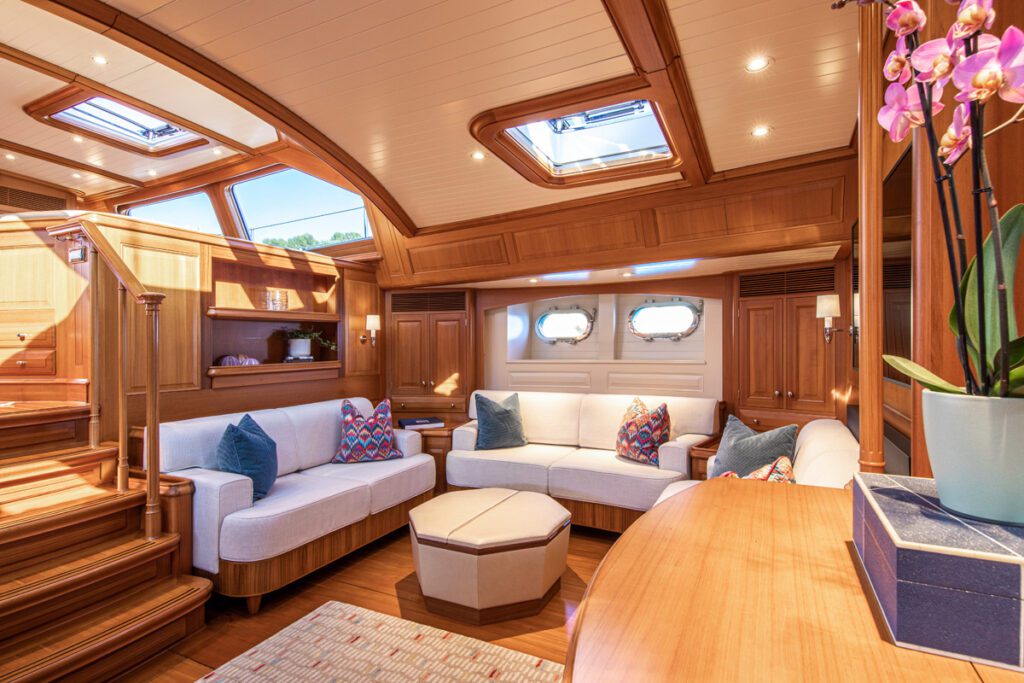Traditional Design and Innovative Thinking Set Sail on an Updated Yacht
During the pandemic, when a lot of people were buying properties sight unseen so they could get away from it all, a retired Michigan couple, taking the advice of their longtime captain, purchased a sailing yacht they had never laid eyes on. They knew that Legend had been launched in 1998 and had been designed […] The post Traditional Design and Innovative Thinking Set Sail on an Updated Yacht appeared first on Ocean Home magazine.


During the pandemic, when a lot of people were buying properties sight unseen so they could get away from it all, a retired Michigan couple, taking the advice of their longtime captain, purchased a sailing yacht they had never laid eyes on.
They knew that Legend had been launched in 1998 and had been designed by Ron Holland, built by Alloy Yachts in New Zealand, and recently undergone a multiyear refit. Lifelong sailors, they received permission to meet the boat and its six-member crew in Malta and immediately set sail for Maine.
When their first adventure ended, they commissioned the eponymous Chicago design firm of Tom Stringer, a fellow sailor and longtime friend, to upgrade the ketch and personalize it to their specifications. Although Stringer has done design work on seven power boats, including one for the Michigan couple, this was his first sailboat refit.

During a yearlong renovation, he updated the rigging and sails, installed new teak decks, new electronics, hydraulics and control systems, and heating and air-conditioning systems. He also updated the lighting and fixtures and outfitted the spaces with new bedding, carpets, window treatments, art, and accessories.
Although the boat’s teak interiors were traditionally styled, they were dark and felt formal and staid, so Stringer remade them in what he calls a “young yachty traditional style” that’s bright, light, and more in sync with the owners’ aesthetics, sensibilities, and lifestyle.
“We preserved the best of the traditional charm but replaced the rest of the soft goods and furniture to reflect a contemporary mood,” he says. “The teak woodwork was modified where necessary to improve function but carefully matched to the original.”



Working with a sophisticated color palette of teak, ivory, and navy accented with pops of red and aqua, Stringer subtly channeled a classic nautical theme. Legend’s hull, which is painted navy, and its crisp white sails set the theme.
“Decorating a boat is different from designing the interior of a house because it has to perform at a higher level, and you have to be concerned about weight and balance,” Stringer says. “Decorative accessories and furnishings have to be fastened down, you have to use performance fabrics that can be cleaned quickly and easily, and key elements like tables have to rotate and get bigger and smaller and higher and lower.”
Because boats are smaller than houses, everything has to fit together like a jigsaw puzzle, and interior and exterior spaces call for a cohesive design that still allows for some personality to shine through.

On the Legend, Stringer used the same wall sconces in every space from stem to stern, and he tied the two mirror-image guest rooms together with different shades of aqua upholstery around the beds.
In the upper salon, Stringer reconfigured and changed the shape and style of the seating, upholstering it in pale tan leather, and added a dining table that converts to a cocktail table. (The serving trays adhere to the tables with magnets.)
One of the more dramatic transformations that required little alteration to achieve was in the galley, where Stringer refinished the natural teak walls in low-sheen white lacquer to create a cheerful yet chic space. He also slightly reconfigured the layout and refitted the appliances.

Storage was of particular importance to the owners, and Stringer made use of every inch of space. In the lower salon, for instance, the octagon-shaped ottoman, which is upholstered in tan leather, opens like a clam to hold board games. The room’s paneled walls and mirrors open to house glassware, and the sofas have pull-out drawers underneath to accommodate dozens of wine bottles.
“The client is a bit of a traditionalist, so this refit suited him well,” Stringer says, adding that his design mission was to “do good work and keep the work out of the way because it’s secondary to the mission, which is to sail.”
With the Legend now up to their design standards, the couple has embarked upon a leisurely two-year-long trip around the world.
“They are sailing for four to six weeks at a time, and they plan to sail into New Zealand by New Year’s,” Stringer says.
The post Traditional Design and Innovative Thinking Set Sail on an Updated Yacht appeared first on Ocean Home magazine.









